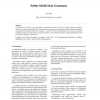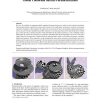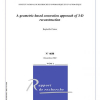SGP
2003
14 years 4 months ago
2003
As the logical next step after sequencing the mouse genome, biologists have developed laboratory methods for rapidly determining where each of the 30K genes in the mouse genome is...
SGP
2003
14 years 4 months ago
2003
In this paper we develop a new description for subdivision surfaces based on a graph grammar formalism. Subdivision schemes are specified by a context sensitive grammar in which ...
SGP
2003
14 years 4 months ago
2003
We introduce multi-chart geometry images, a new representation for arbitrary surfaces. It is created by resampling a surface onto a regular 2D grid. Whereas the original scheme of...
SGP
2003
14 years 4 months ago
2003
We present an algorithm for meshing surfaces that is a simple adaptation of a greedy “farthest point” technique proposed by Chew. Given a surface S, it progressively adds poin...
SGP
2003
14 years 4 months ago
2003
We present “contact levels of detail” (CLOD), a novel concept for multiresolution collision detection. Given a polyhedral model, our algorithm automatically builds a “dual h...
SGP
2003
14 years 4 months ago
2003
Previous parametric representations of smooth genus-zero surfaces require a collection of abutting patches (e.g. splines, NURBS, recursively subdivided polygons). We introduce a s...
SGP
2003
14 years 4 months ago
2003
One of the challenges in 3D shape matching arises from the fact that in many applications, models should be considered to be the same if they differ by a rotation. Consequently, w...
SGP
2003
14 years 4 months ago
2003
We propose a scheme for modeling point sample geometry with statistical analysis. In our scheme we depart from the current schemes that deterministically represent the attributes ...
SGP
2003
14 years 4 months ago
2003
We solve the problem of computing global conformal parameterizations for surfaces with nontrivial topologies. The parameterization is global in the sense that it preserves the con...
SGP
2003
14 years 4 months ago
2003



